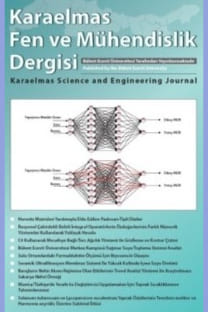The Sucrose Determination From Gummy Candy with Imprinted Polymer
Sucrose is a valuable carbohydrate because of its broad usage in the chemical, microbiological, pharmaceutical, and food industries. The determination of sucrose content in all of these products is very desirable process. The molecularly imprinted polymers are candidate materials for analyzing carbohydrates without any derivatization. In this study; we synthesized 2,6-bis(acrylamido) pyridine as a designed monomer and also crosslinker. Spectroscopic characterization studies (FTIR and NMR) were carried out the monomer and for the sucrose-monomer complex. The sucrose imprinted polymer was used to determine sucrose from gummy candy. The 60 % of sucrose was recognized from gummy candy by sucrose imprinted polymer.
The Sucrose Determination From Gummy Candy with Imprinted Polymer
Sükroz kimya, mikrobiyoloji, farmakoloji ve gıda endüstrisinde yaygın kullanımından dolayı oldukça önemli bir karbohidrattır. Tüm bu alanlarda oluşturulan ürünlerden sükroz içeriğinin hassas tayini oldukça istenen bir prosestir. Bu yüzden baskılanmış polimerler karbohidratların türevlendirilmeden analizlenebilmesi için aday materyallerdir. Çalışmada 2,6-bis(akrilamido) piridin hem monomer hem de çapraz bağlayıcı gibi kullanılmak üzere sentezlendi. Monomer ve monomer-sükroz kompleksinin spektroskopik analizleri yapıldı (FTIR ve NMR). Hazırlanan sükroz baskılı polimer jelibon şekerden sükroz belirlenmesi için kullanıldı. Jelibon şekerden baskılı polimerin sükrozu tanıma kapasitesi % 60 olarak bulundu.
___
- Athikomrattanakul, U., Katterle, M., Eichelmann, NG., Scheller, FW. 2009. Development of molecularly imprinted polymers for the binding of nitrofurantoin. Biosens. Bioelectron., 25: 82–87.
- Bergmann, NM., Peppas, NA. 2008. Molecularly imprinted polymers with specific recognition for macromolecules and protein. Prog. Polym. Sci., 33:271–288.
- Cadet, F., Offmann, B. 1997. Direct spectroscopic sucrose determination of raw sugar cane juices. J. Agric. Food Chem., 45:166-171.
- Finley, JW.,.Fellers, DA. 1973. Sucrose determination by a modified anthrone method. Application with sweetened wheat-soy blend and corn-soy-milk. Cereal Chem., 50:210-215.
- Gómez-Pineda, LE., Pina-Luis, GE., Cuán, A., García- Calzón, JA., Díaz-García, ME. 2011. Physico-chemical characterization of flavonol molecularly imprinted polymers. React. Funct. Poly., 71:402–408.
- Kirk, C., Jensen, M., Kjaer, CN., Smedskjaer, MM., Larsen, KL., Wimmer, RD. 2009. Aqueous batch rebinding and selectivity studies on sucrose imprinted polymers. Biosens. Bioelectron, 25:623–628.
- Kirkbride, KC., Townsend, TA., Bruinsma, MW., Barnett, JV., Blobe GC. 2008. Bone morphogenetic proteins signal through the transforming growth factor-beta type III receptor. J Biol Chem, 283:7628–7637.
- Kumar, V., Pattabiraman, TN. 1997. Standardization of a colorimetric method for the determination of fructose using o-cresol: Sulphuric acid reagent. Ind. J. Clin. Biochem., 12:95- 99.
- Kryscio, DR., Peppas, NA. 2012. Critical review and perspective of macromolecularly imprinted polymers. Acta Biomaterialia. 8:461–473.
- Manesiotis, P., Hall, AJ., Courtois, J., Irgum, K., Sellergren, B. 2005. An artificial riboflavin receptor prepared by a template analogue imprinting strategy. Angew. Chem. Int. Ed., 44:3902 –3906.
- Miller, GL. 1959. Use of dinitrosalicylic acid reagent for determination of reducing sugar. Anal. Chem., 31:426-428.
- Nojiri, S., Taguchi, N., Oishi, M., Suzuki, S. 2000. Determination of sugar alcohols in confectioneries by highperformance liquid chromatography after nitrobenzoylation. J Chromatogr A, 893:195–200.
- Okutucu, B., Önal, S., Telefoncu, A. 2009. Noncovalently galactose imprinted polymer for the recognition of different saccharides. Talanta, 78:1190-1193.
- Okutucu, B., Önal, S. 2011. Molecularly imprinted polymer for separation of various sugars from human urine. Talanta, 87:74-79.
- Oikawa, E., Motami, KT., Aoki, O. 1993. Synthesis and properties of poly(thioether amide)s from 2,6-bis(acrylamido) pyridine and dithiols. Polym. Sci. Part A: Polym. Chem., 31:457- 465.
- Shekarchizadeh, H., Ensafi, AA., Kadivari, M. 2013. Selective determination of sucrose based on electropolymerized molecularly imprinted polymer modified multiwall carbon nanotubes/glassy carbon electrode. Mater. Sci. Eng. C, 33:3553–3561.
- Tanabe, K., Takeuch,i T., Matsui, J., Ikebukuro, K., Yano, K., Karube, I. 1995. Recognition of barbiturates in molecularly imprinted copolymers using multiple hydrogen bonding. J. Chem. Soc. Chem. Commun., 24:2303-2304.
- Toma, LA., Foster, N. 2010. Development of a molecularly imprinted polymer for the analysis of avermectin. Anal. Chim. Acta, 680:79–85.
- Umpleby II, RJ., Baxter, SC., Rampey, AM., Rushton, GT., Chen, Y., Shimizu, KD. 2004. Characterization of the heterogeneous binding site affinity distributions in molecularly imprinted polymers. J. Chromatogr. B, 804:141-149.
- Zhang H. 2014. Water-compatible molecularly imprinted polymers: Promising synthetic substitutes for biological receptors. Polymer., 55:699-714.
- ISSN: 2146-4987
- Yayın Aralığı: Yılda 2 Sayı
- Başlangıç: 2011
- Yayıncı: ZONGULDAK BÜLENT ECEVİT ÜNİVERSİTESİ
Sayıdaki Diğer Makaleler
Bazı 2-Normlu Dizi Uzayları Üzerinde Superposition Operatörü
Dağılımlı Bir Ortamda Doğrusal Olmayan Reaksiyon Model Denkleminin Yarı Analitik Çözümleri
ZEHRA PINAR, HÜSEYİN KOÇAK, Yasser DAOUD
Bazı Gadjiev İbragimov Tipli Operatörlerin Karşılaştırma Sonuçları
Nazmiye GÖNÜL BİLGİN, Nurullah COŞKUN
$I₂$ -Convergence of Double Sequences in Topological Groups
Toplu Taşımada Çok lı Karar Verme ve Metropoliten Bir Alanda Servis Araçlarının Modellemesi
Mehmet Fatih ALTAN, Mehmet Çağrı KIZILTAŞ, Süleyman Cem DİVRİK
MUSTAFA GÖÇKEN, ASLI BORU İPEK, AYŞE TUĞBA DOSDOĞRU
Diferansiyel Formlar ile Diferansiyel Operatörlerin Genelleştirilmesi
